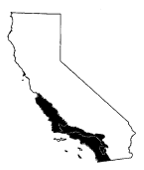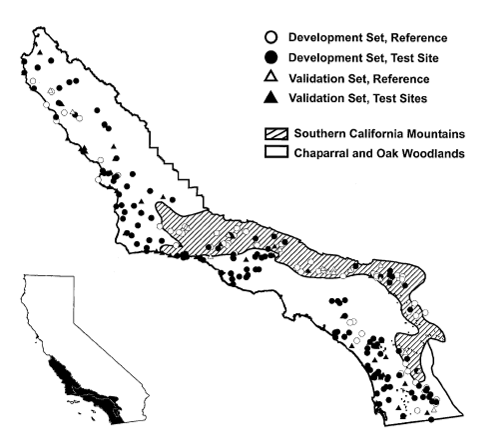
Tools – South & Central Coast IBI
Steps to Calculate the Southern and Central California Index of Biotic Integrity (IBI)
- 1. Determine if your site is within the appropriate region for the IBI.

Note: The IBI is appropriate for the entire SMC region.
- 2. Determine which Omernik Level III ecoregion your site is in (i.e,. Southern California Mountains or Southern and Central California Oak Woodland and Chaparral). NOTE: Elevation is not an appropriate way to determine ecoregion.
GIS layers may be downloaded from the EPA. A kml file (for use in Google
Earth) is distributed with this SOP.

- 3. Exclude specified taxa (refer to section 3.4 of SAFIT’s Rules for the Development and Maintenance of the Standard Level of Taxonomic Effort for a full list of excluded taxonomic groups):
- a. Copepods
- b. Cladocerans
- c. Parasites and commensals
- d. Neustonic and shore-dwelling taxa (e.g., water striders, collembola, ground beetles)
- e. Specimens that were dead prior to sampling
- f. Terrestrial taxa (e.g. ants)
- SAFIT documents may be downloaded here.
- 4. Convert all identifications to SAFIT Level I
- 5. Check number of organisms in the sample:
- a. Fewer than 450 organisms: IBI may not be valid. Interpret IBI values with caution. Do not alter data.
- b. 450-500 organisms: Do not alter data.
- c. More than 500 organisms: Reduce to 500 organisms by randomly selecting organisms without replacement. (Please contact Raphael Mazor if you need assistance generating a subsampled dataset).
- 6. Calculate the 7 metrics:
- a. Coleoptera Taxa
- b. EPT Taxa
- c. Predator Taxa
- d. % Collector individuals
- e. % Intolerant (i.e. CTV <3) individuals
- f. % Non-insect taxa
- g. % Tolerant (i.e. CTV >7) taxa
- It is identified in the taxonomic resolultion specified in the STE; or
- The taxonomist noted that the identification was "distinct"; or
- There are no other taxa in the sample that it could include.
Information on tolerance values and functional feeding groups are found in CAMLnet (2003).
Note that 3 of these metrics (a, b, and c) are based on raw totals, 2 (d and e) are percents of the total number of individuals, and 2 (f and g) are percents of the
total number of taxa.
Also note that 5 of these metrics (a, b, c, f, and g) are based on taxa and 2 (e and f) are based on numbers of individuals.
Special note on calculating richness-based metrics:
When calculating metrics based on numbers of taxa (a, b, c, f, and g), make sure to exclude taxa that may be redundant within a sample. To determine if a taxon is unique within a sample, it must meet one of three criteria:
The first two criteria are relatively straightforward. Application of the third criterion varies from sample to sample, as illustrated below:
| Sample 1 | Sample 2 | Sample 3 |
|---|---|---|
| Baetis sp Centroptilum sp |
Baetis sp Baetis bicaudarus Centroptilum sp |
Baetis sp-Distinct Baetis bicaudarus Centroptilum sp |
| EPT Richness = 2 | EPT Richness = 2 | EPT Richness = 3 |
In samples 1 and 2, the EPT richness is calculated as two. In Sample 1, Baetis sp meets the third criteria because it is not redundant with any other taxa in the sample. In Sample 2, Baetis sp is excluded because the identification is redundant with Baetis bicaudatus—we have no certainty that the three identifications represent three dis.tinct taxa. In sample 3, the identification is marked “Distinct” because the taxonomist was certain that the specimens were not Baetis bicaudatus (although he or she was not able to determine the correct species-level
identification). Therefore Sample 3 has an EPT Richness of three.
- 7. Score the 7 metrics according to Table 3 in Ode et al. 2005. Note that 3 metrics (b, d, and e) have different scores, depending on the ecoregion in which the site is located. Scoring tables are provided below.
- 8. Sum Scores, and multiply by 100/70 to adjust to a 100-point scale.
Coleoptera Taxa1 Score Metric Value 0 0 2 1 4 2 5 3 7 4 8 5 10 6+ EPT Taxa Score Metric Value (Chaparral) Metric Value (Mountains) 0 0-1 0-4 1 2-3 5-6 2 4 7 3 5-6 8-9 4 7-8 10 5 9-10 11-12 6 11-12 13 7 13-14 14-15 8 15 16 9 16-17 17-18 10 18+ 19+ Preditor Taxa Score Metric Value 0 0-3 1 4 2 5 3 6 4 7 5 8 6 9 7 10 8 11 9 12 10 13+ % Collector Individuals Score Metric Value (Chaparral) Metric Value (Mountains) 0 97-100 95-100 1 93-96 89-94 2 89-92 83-88 3 85-88 77-82 4 81-84 71-76 5 76-80 65-70 6 72-75 59-64 7 68-71 53-58 8 64-67 47-52 9 60-63 40-46 10 0-59 0-39 % Intolerant Individuals Score Metric Value (Chaparral) Metric Value (Mountains) 0 0 0-1 1 1-3 2-5 2 4-6 6-9 3 7-9 10-13 4 10-12 14-18 5 13-15 19-22 6 16-18 23-26 7 19-20 27-31 8 21-22 32-36 9 23-24 37-41 10 25-100 42-100 % Non-insect Taxa Score Metric Value 0 47-100 1 43-46 2 39-42 3 35-38 4 30-34 5 26-29 6 22-25 7 18-21 8 13-17 9 9-12 10 0-8 % Tolerant Taxa Score Metric Value 0 48-100 1 34-37 2 30-33 3 26-29 4 23-25 5 26-29 6 20-22 7 13-16 8 9-12 9 5-8 10 0-4
References
- Ode et al.
- CAMLnet. 2003. List of California Macroinvertebrate Taxa and Standard Taxonomic Effort. Aquatic Bioassesment Laboratory. Rancho Cordova, CA.
- Ode, P.R., Rehn, A.C., and May, J.T. 2005. A quantitative tool for assessing the integrity of southern California coastal streams. Environmental Management. 35: 493-504.


